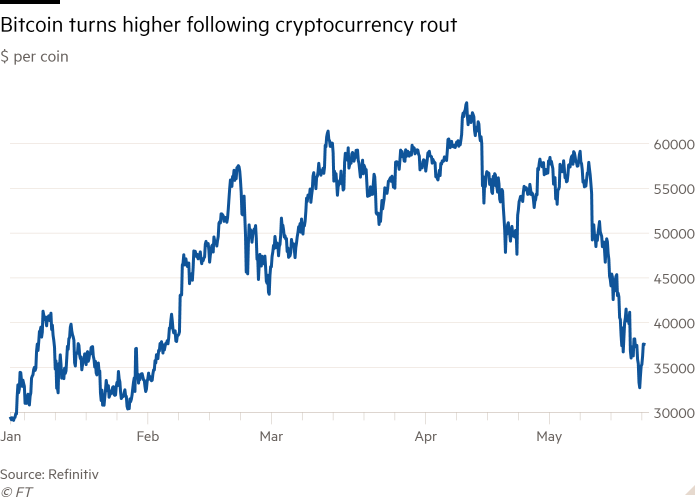Stocks on Wall Street advance following cryptocurrency jitters
Investors on Wall Street looked past last week’s cryptocurrency jitters to send stocks higher, led by the technology and energy sectors.
The blue-chip S&P 500 rose 0.8 per cent in early trades and the tech-focused Nasdaq Composite index gained 1.2 per cent.
Energy stocks were among the best performers after Goldman Sachs forecast Brent crude, which climbed 2.1 per cent to $67.86 a barrel on Monday, would reach $80 this year as economies recovered from the pandemic.
Wall Street was rattled last week by the prospect that a cryptocurrency rout could ripple into other asset classes. Bitcoin fell 13 per cent on Sunday, before surging 10 per cent on Monday, but it remains more than 40 per cent below its April peak.
Analysts are examining correlations between trends in cryptocurrency and other markets, such as richly valued tech stocks, citing the possibility that investors who borrowed money to trade digital currencies could sell other assets to offset losses.
“The cross-asset consequences have been mild,” said John Normand, strategist at JPMorgan. But he warned that a deflation of what he defined as a $2tn market could create “a substantial wealth loss, which can impact the real economy by impairing the balance sheets of households, corporates and the banking sector”.
The People’s Bank of China has warned financial institutions against using digital currencies for payments while the US government said cryptocurrency transactions exceeding $100,000 should be reported to tax authorities.

The S&P has traded choppily since closing at an all-time high on May 7. Almost nine out of 10 S&P-listed companies beat earnings forecasts for the first quarter, according to DataTrek Research.
US equities would remain volatile, DataTrek’s Nicholas Colas said, until companies reported second-quarter results and investors could assess whether the first three months of this year represented the peak of the recovery from last year’s industry shutdowns.
“The volatility you see in stock prices day to day is the tug of war between earnings bulls and bears,” Colas said.
The yield on the 10-year US Treasury bond, which moves inversely to its price, declined 0.02 percentage points to 1.613 per cent.
This yield, which sets the tone for equity valuations and global borrowing costs, has risen from about 0.9 per cent at the start of the year. It has stayed within a narrow range for the past month as Federal Reserve rate-setters repeated a long-held message that jumps in inflation would be transitory as the economy recovers.
“I’m still leaning bearish on bonds,” said Jack McIntyre, fixed income portfolio manager at Brandywine Global, as the Fed inched towards discussion of tapering of its $120bn of monthly bond purchases.
“But it is going to be more of a gradual slowdown,” he added, as investors in the eurozone and Japan, where income yields from government bonds are lower, “find 1.6 per cent quite attractive”.
In currencies, the dollar index fell 0.3 per cent. The measure of the greenback against trading partners’ currencies has declined 3.7 per cent in the past quarter.
“President Joe Biden’s plan to raise the corporate tax rate stands to hurt US producers’ competitiveness and dissuade investment in the country,” said Tan Kai Xian of research house Gavekal.
The euro added 0.4 per cent against the dollar to $1.2226, remaining around its highest point since January.
Read More: Stocks on Wall Street advance following cryptocurrency jitters














